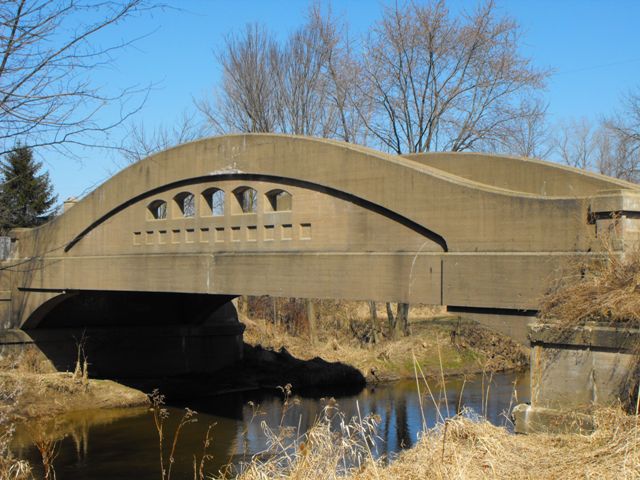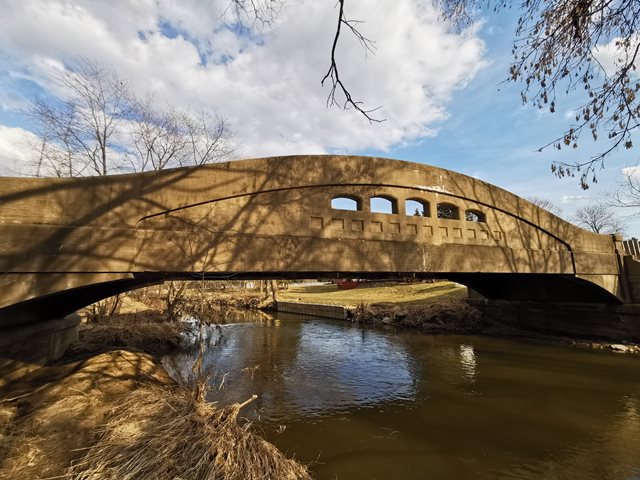We Recommend:
Bach Steel - Experts at historic truss bridge restoration.
BridgeHunter.com Phase 1 is released to the public! - Visit Now
Grange Road Bridge

Primary Photographer(s): Nathan Holth
Bridge Documented: Summer 2005, March 25, 2010, March 16, 2022, and April 23, 2022
Rural: Clinton County, Michigan: United States
1923 By Builder/Contractor: Price Brothers Company of Lansing, Michigan and Engineer/Design: Michigan State Highway Department
Not Available or Not Applicable
90.0 Feet (27.4 Meters)
92.0 Feet (28 Meters)
20 Feet (6.1 Meters)
1 Main Span(s)
19200023000B020

View Information About HSR Ratings
Bridge Documentation
2022 Update: A very irritating development is that the one surviving original plaque on this bridge has been stolen!
Original Narrative:
The Grange Road Bridge, built in 1923, is among the older examples of Michigan's beautiful and historic concrete camelbacks, also known as curved chord through girder bridges, yet it remains in remarkably good condition. The Grange Road Bridge is an example of the 90 foot plan, which was the largest span size included in the set of state standard plans for this bridge type.
The bridge retains an excellent degree of historic integrity as well.
There is no weight limit posted for this bridge, which has a 20 foot wide deck and carries a light to medium volume of rural arterial traffic. Because of its historic integrity, good structural condition, and rural location, this bridge should be given preservation priority.
Recommended Future Preservation Work
When concrete develops severe deterioration, it becomes very difficult to rehabilitate the bridge, and even harder to execute such a rehabilitation without destroying or covering up much of the original bridge material. There is currently what appears to be minor and isolated deterioration on the bridge. This means the time for corrective action is now. Costs for repair will be lower, and the life of the historic bridge can be extended longer and more effectively by taking action now.
There is minor cracking at the center of the girders and also at the end posts. There is also minor spalling and delaminating around sections of reinforcing rods (rebar) on the bridge. Repair of these areas is recommended before they expand into the more widespread spalling that plaques many other examples of this historic bridge type.
There is dirt buildup along the edges of the deck next to the girders, which is substantial enough to support weeds in the summer. This should all be removed from the bridge deck, an easy fix that will reduce the presence of moisture on the bridge.
Drainage for the bridge, which appears to be an original feature on the bridge, has a minor design flaw. The drains are positioned such that water exits the drain and tends to run down the side of the portion of the girder which extends below the deck. Installation of pipes within the existing drains which would carry the water beyond the bottom of the girders before discharging it into the river below would correct this problem.
Finally, although the practice is widespread, an asphalt wearing surface has been placed upon the concrete deck of the bridge. It is the opinion of HistoricBridges.org that the problems caused by laying asphalt on top of concrete decks on historic bridges (moisture entrapment, lack of inspection/repair access) outweigh any benefit that such a surface may provide.
Michigan's Concrete Camelback Bridges
All of Michigan's surviving curved chord through girders should be considered historically and technologically significant. The bridges are historically significant because they represent a unique and innovative design developed by the Michigan State Highway Department in its earlier years of bridge construction.
The bridges should be considered technologically significant as well. By incorporating a curve into the design, Michigan State Highway Department not only increased the efficiency of the design, they also greatly increased the aesthetic value of the bridges. The graceful curves of this bridge type, complemented by architectural details such as inset rectangles and pierced openings, make them among the most aesthetically pleasing of bridge types ever encountered. Straight chord through girder bridges are generally considered among the more plain and less visually appealing types of historic bridges. The aesthetic qualities of the curved girder bridge, those qualities being an integral and functional part of the bridge and not a decorative facade, should be considered to be a technologically significant feat: an extremely effective union of function and form.
Also, the 90 foot plan concrete camelbacks, including the Grange Road Bridge are all noteworthy on a national level because they are among the longest spans seen in concrete through girders throughout the country. They represented the maximum potential of the bridge type, which had a short life because it was limited as a practical structure type in terms of span length and deck width. Most concrete through girders (including the small number of curved chord examples outside Michigan) throughout the country appear to have been limited to no more than 60 feet. With their 90 foot spans, Michigan's 90 foot plan concrete camelbacks push beyond this number considerably.
Statewide, very few examples of this bridge type have been preserved or have evidence of a preservation commitment. Further, the number of examples of this bridge type have been dropping rapidly over the years. Considering that in recent years, Michigan has begun to emerge as a leader in truss bridge preservation, it is reasonable to consider concrete camelback bridges to be the most threatened type of historic bridge in Michigan.
The bridge type has become rare through attrition in Michigan, and the rarity of the bridges today only adds to the significance of those remaining examples.
Learn about Michigan's Unique Concrete Camelback Bridges
This bridge is tagged with the following special condition(s): Unorganized Photos
![]()
Photo Galleries and Videos: Grange Road Bridge
2010 Bridge Photo-Documentation
Original / Full Size PhotosA collection of overview and detail photos, taken March 25, 2010. This gallery offers photos in the highest available resolution and file size in a touch-friendly popup viewer.
Alternatively, Browse Without Using Viewer
![]()
2010 Bridge Photo-Documentation
Mobile Optimized PhotosA collection of overview and detail photos, taken March 25, 2010. This gallery features data-friendly, fast-loading photos in a touch-friendly popup viewer.
Alternatively, Browse Without Using Viewer
![]()
2005 Bridge Photo-Documentation
A collection of overview and detail photos, taken Summer 2005. This photo gallery contains a combination of Original Size photos and Mobile Optimized photos in a touch-friendly popup viewer.Alternatively, Browse Without Using Viewer
![]()
Post-2021 Additional Unorganized Photos
Original / Full Size PhotosA supplemental collection of photos that are from additional visit(s) to the bridge and have not been organized or captioned. This gallery offers photos in the highest available resolution and file size in a touch-friendly popup viewer.
Alternatively, Browse Without Using Viewer
![]()
Post-2021 Additional Unorganized Photos
Mobile Optimized PhotosA supplemental collection of photos that are from additional visit(s) to the bridge and have not been organized or captioned. This gallery features data-friendly, fast-loading photos in a touch-friendly popup viewer.
Alternatively, Browse Without Using Viewer
![]()
Maps and Links: Grange Road Bridge
Coordinates (Latitude, Longitude):
Search For Additional Bridge Listings:
Bridgehunter.com: View listed bridges within 0.5 miles (0.8 kilometers) of this bridge.
Bridgehunter.com: View listed bridges within 10 miles (16 kilometers) of this bridge.
Additional Maps:
Google Streetview (If Available)
GeoHack (Additional Links and Coordinates)
Apple Maps (Via DuckDuckGo Search)
Apple Maps (Apple devices only)
Android: Open Location In Your Map or GPS App
Flickr Gallery (Find Nearby Photos)
Wikimedia Commons (Find Nearby Photos)
Directions Via Sygic For Android
Directions Via Sygic For iOS and Android Dolphin Browser
USGS National Map (United States Only)
Historical USGS Topo Maps (United States Only)
Historic Aerials (United States Only)
CalTopo Maps (United States Only)



